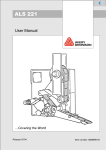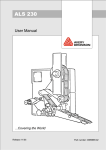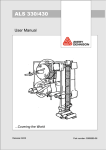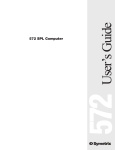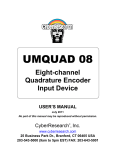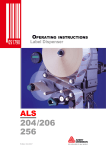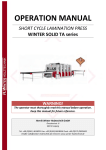Download Avery Dennison ALS 421 Technical information
Transcript
Release 2/08 Artikelnummer: 0089999-08 Operators Manual ALS 321/421 Contents 1. Important Notes........................................................................................................ 3 1.1 Overview....................................................................................................................................... 3 1.1.1 Manufacturer...................................................................................................................... 3 1.1.2 Copyright............................................................................................................................ 3 1.2 Safety............................................................................................................................................ 4 1.2.1 General Safety Notes ........................................................................................................ 4 1.2.2 Warning Notes in the Text ................................................................................................. 4 1.2.3 Operator’s duty of care ...................................................................................................... 5 1.2.4 Concrete security regulations and symbols used .............................................................. 6 1.2.5 Security measures during normal operation...................................................................... 7 1.2.6 Security measures during maintenance and repairs ......................................................... 7 1.2.7 Work on the electrical equipment ...................................................................................... 8 1.2.8 Work on pneumatic equipment.......................................................................................... 8 1.2.9 Observe environmental regulations................................................................................... 8 2. Description ............................................................................................................... 9 2.1 Mechanics .................................................................................................................................... 9 2.2 Operator panel............................................................................................................................ 11 2.3 Plug board .................................................................................................................................. 12 2.4 Electronics .................................................................................................................................. 12 3. Labelling................................................................................................................. 13 3.1 Threading the Material................................................................................................................ 13 3.1.1 Removing label material .................................................................................................. 14 3.1.2 Mounting a new label roll ................................................................................................. 14 3.1.3 Adjusting the pressure roller ............................................................................................ 16 3.1.4 Lead screw adjustment.................................................................................................... 17 Adjust pressure roller.................................................................................................................. 18 3.2 Starting labelling ......................................................................................................................... 18 3.3 Using the FEED key to measure the label pitch......................................................................... 19 3.4 Missing label function and web breaks....................................................................................... 19 3.5 Control of the labelling................................................................................................................ 19 3.6 Maintenance ............................................................................................................................... 20 4. Connections ........................................................................................................... 21 4.1 Output signals............................................................................................................................. 21 4.1.1 Error and warning output ................................................................................................. 21 4.1.2 Printer output ................................................................................................................... 21 4.1.3 OD-Control output............................................................................................................ 21 4.1.4 Ready output ................................................................................................................... 21 4.1.5 Labelling signals .............................................................................................................. 22 4.2 Input signals ............................................................................................................................... 23 Release 2/08 Page 1 Important Notes Operators Manual ALS 321/421 4.2.1 Product sensor .................................................................................................................24 4.2.2 OD Control sensor ...........................................................................................................25 4.2.3 Control signals .................................................................................................................26 4.3 EMI..............................................................................................................................................31 5. Errors and warnings ............................................................................................... 32 1.1 Dispenser error messages ...........................................................................................................32 1.2 Dispenser warnings ......................................................................................................................33 1.3 STO! Power-fail message.............................................................................................................33 6. Technical specification ........................................................................................... 34 6.1 Technical Information..................................................................................................................34 6.2 Application specification..............................................................................................................35 6.3 Performance charts.....................................................................................................................35 Release 2/08 Page 2 Important Notes Operators Manual ALS 321/421 1. Important Notes 1.1 Overview The ALS 321/421 is a fully automatic labeller. Operation is very easy and can be learned with a minimum of training. The machine is controlled by a microprocessor and because of its programmable possibilities it can be used in many applications. Except for cleaning the rolls and light sensor there is no periodical maintenance necessary. This manual should help you to operate the ALS 321/421. For technical questions, especially in the case of a problem, your local AVERY service organisation will be pleased to help you. Note: This manual is valid for all ALS 321/431 devices which are equipped with software version 2.2. Compared to other software versions, there may be differences in operation and functionality. 1.1.1 Manufacturer This machine was manufactured by: AVERY Maschinen GmbH Ohmstrasse 3 85386 Eching Deutschland Tel. Fax 1.1.2 +49-(0)8165-925-0 +49-(0)8165-3143 Copyright © 2004 Avery Maschinen GmbH. All rights reserved. No part of this work covered by Avery's copyright may be reproduced or copied in any form or by any means (graphic, electronic or mechanical, including photocopying, recording, recording taping, or information and retrieval systems) without the written permission of Avery Maschinen GmbH. Avery also reserves all other rights, including the right to make changes or corrections at any time without notice. Avery make no representation or warranties about the accuracy, currency, completeness or suitability of the information provided herein and will not be held liable for any use of this information for any purpose. It is provided "as is" without express or implied warranty. AVERY and all other related brands and product names are trademarks of Avery Dennison Corporation. No licence to use or reproduce any of these trademarks or other trademarks of Avery Dennison Corporation is given or implied. All other brand and product names are the trademark of their respective owners. Release 2/08 Page 3 Important Notes Operators Manual ALS 321/421 1.2 Safety 1.2.1 General Safety Notes In order to avoid any risk of injury due to squeezing between the fixed dispensing edge and the passing product, it may be necessary to add a protection cover in front of the dispensing edge. The necessity for this has to be decided on case by case. See also regulation EN 292 and 294. 1.2.2 Warning Notes in the Text In this description, two types of notes can be found: Warning note – indicates a possible risque of injury for the user. Ignoring the warning can lead to injuries or material damages. Example: CAUTION! - The machine is connected to mains. Only authorised personnel may open the cover. Operation without this cover is not allowed. Special advice regarding the carrying out – please notice! Example: Note: Please take note of the given notes and advices. They serve your safety as well as the preservation of value of the machine. Release 2/08 Page 4 Important Notes Operators Manual ALS 321/421 1.2.3 Operator’s duty of care The machine was designed and constructed taking into account a hazard analysis and after careful selection of the harmonised standards to be observed, as well as other technical specifications. Thus, it corresponds to the state of the art and allows the highest possible degree of safety during operation. The safety of the machine, however, can only be put into operating practice if all measures required for the safety are taken. It falls within the operator‘s duty of care to plan these measures and to verify their implementation. Above all, the operator must make sure that • the machine is only used in accordance with its purpose (cf. the section “Use in accordance with the purpose” in the chapter “Specification”) • the machine is only operated in faultless serviceable condition and that especially the safety devices are regularly checked with respect to their serviceability • the required personal protective clothing and equipment for operating, maintenance and repair personnel are available and are being used • a legible and complete copy of the operating instructions is always available at the place of operation of the machine • only personnel which is qualified and authorised for it will operate, service, and repair the machine • this personnel is instructed in all relevant issues of occupational safety and environmental protection on a regular basis and is familiar with the operating instructions and especially the safety instructions contained therein • all safety and warning instructions on the machine itself are not removed and are legible Release 2/08 Page 5 Important Notes Operators Manual ALS 321/421 1.2.4 Concrete security regulations and symbols used In the following operating instructions, concrete security regulations are indicated in order to point out the remaining risks which cannot be avoided when operating the machine. These remaining risks include danger to • • • Persons Product and machine Environment The symbols used in the operating instructions are above all intended to point out the security regulations! This symbol indicates that especially danger to persons has to be expected. (Lethal danger, danger of injury) This symbol indicates that especially danger to the machine, material, and the environment has to be expected. The most important aim of the security regulations is to avoid injuries to a person. • Whenever there is a warning triangle with the caption “Danger” in front of a security regulation, dangers to the machine, materials, and the environment are not excluded. • Whenever there is a warning triangle with the caption “Warning” in front of a security regulation, a danger to persons, however, must not be expected. The symbol used in each case, however, cannot replace the text of the security instruction. Thus, it is necessary to always read the text completely! This symbol does not indicate security regulations, but provides information for a better understanding of the machine’s operations. Release 2/08 Page 6 Important Notes Operators Manual ALS 321/421 1.2.5 Security measures during normal operation The machine may only be operated by trained and authorised persons who are familiar with the operating instructions and are able to work in accordance with it! • Before starting the machine, check and make sure that • only authorised personnel is staying in the operating area of the machine • Nobody can get hurt when the machine is started! • Before every production start-up, the machine must be checked for visible damage and it must be made sure that it is only operated in faultless working condition! Any defects found must be immediately reported to the supervisor! Before every production start-up, all materials/objects that are not necessary for production must be removed from the operating area of the machine! Before every production start-up, it must be checked and made sure that all safety devices function in a correct manner! 1.2.6 Security measures during maintenance and repairs Inspection and maintenance periods laid down in the operating instructions must be observed! Observe maintenance and repair instructions in these operating instructions, which refer to individual components! Before performing maintenance and repair work, the access to the operating area of the machine must be prohibited for unauthorised personnel! Post or put up a sign, which indicates the maintenance, or repair work! Before performing maintenance and repair work, turn off the main switch for the electric power supply and secure it with a padlock!. The key to this padlock must be in the hands of the person who performs the maintenance or repair work! When exchanging heavy machine parts, use only suitable and faultless load suspension devices and stopping devices! Release 2/08 Page 7 Important Notes Operators Manual ALS 321/421 1.2.7 Work on the electrical equipment Repair work on the electrical equipment of the machine may only be performed by a trained electrician! Electrical equipment must be checked on a regular basis! Loose connections must be fixed again! Exchange damaged lines/cables immediately! Always keep the switch cabinet closed! Access is only allowed to authorised personnel with keys/tools! Never wash down switch cabinets and other housings of electrical equipment with a water hose for cleaning! 1.2.8 Work on pneumatic equipment Maintenance and repair work on pneumatic equipment may only be performed by specially trained personnel! Before starting maintenance and repair work, depressurise the pneumatic equipment of the machine! By way of precautionary maintenance, exchange hose pipes on a regular basis, even if there is no damage to be detected! (Observe the manufacturers’ instructions!) Before setting into operation after maintenance or repair works • check if loosened screwed connections are tight • make sure that removed coverings are re-installed After termination of maintenance and repair work and before restarting the production, make sure that • all materials, tools, and other equipment required for maintenance and repair work are removed from the operating area of the plant • all safety devices of the plant function in a faultless manner! 1.2.9 Observe environmental regulations During any and all work on and with the machine, the statutory duties concerning prevention of waste and the proper waste disposal/recycling regulations must be observed. Especially in the case of installation, repair and maintenance work, substances which are hazardous for the water, such as detergents containing dissolvents, may not pollute the soil or get into the sewage system! These substances must be stored, transported, collected, and disposed of in appropriate containers! Release 2/08 Page 8 Important Notes Operators Manual ALS 321/421 2. Description CAUTION! - The machine is connected to mains. Only authorised personnel may open the cover. Operation without this cover is not allowed. This chapter explains the structure and the function of the labeller. The expressions used are explained here. 2.1 Mechanics The labeller is available in a right-hand or a left-hand version. The expression right or left is related to the direction of product transport. The material is unwound from the label roll (3). The maximum diameter of the label roll is 300 mm. The width of the backing paper is 155mm for a 321 and 230mm for a 421 machine. The label roll is guided by a swing away lever (4). The dancer arm (011) keeps the material tight and the acceleration forces low. The deviator roller (8) allows the use of inside or outside wound label web. The deviator roller (9) guides the material to the dispensing edge. Paper brake brush (6) applies a brake force to the label web and keeps the label web under a certain tension without disturbing the movement. At the dispensing edge (10) the label sensor (15) is mounted. It detects the gap between the labels. The sensor includes a light source and a light receiver. The software can adjust the sensitivity. With this information, the machine calculates the position of the label. At the dispensing edge (10) the label is separated from the backing paper and moved to the product. With a foam roller (16) in front of the dispensing edge, the label is applied to the product. The deviator rolls (5) guides the backing material to the drive roller (1). The drive roller (1) moves the label web according to the adjusted dispensing speed. The pressure roll (12) has to be positioned in the centre of the label web, in order to guide the web straight on track. By means of the knurled screws, the pressure roller is held in its required lateral position on the shaft. With its handle the pressure roller (12) will be opened and closed. When inserting the material the pressure roller has to be opened. The deviator roller (17) guides the backing paper to the rewind mandrel (13). The rewind mandrel should always be set to expanded position when mounting a new roll of labels. This allows an easy removal of the collected backing material. To ensure a reliable run of the label web the guides (18) have to be adjusted according to the width of the labels in use. Release 2/08 Page 9 Description Operators Manual ALS 321/421 Figure 1 Machine layout Apart from the drive roller (1), and the material brush (6) the labeller has no mechanical wearing parts. The operator panel (19) is described in the next section of this chapter. Release 2/08 Page 10 Description Operators Manual ALS 321/421 2.2 Operator panel The operator panel of the 321/421 is shown in Figure 2, it has 4 digit LED and 6 membrane keys. Figure 2 Operator panel The six membrane keys have the following functions: FEED: By pressing this key one label will be dispensed. An error or warning indication may be cleared with this key. Additionally, each time the FEED key is pressed the machine measures the distance to the next leading label edge and stores this measurement as the label pitch. CONTRAST: With this key the contrast value of the label sensor can be adjusted to the label material in use. SPEED UP / With these keys the labelling speed can be adjusted DOWN POSITION These keys enable the adjustment of the start delay function, i.e. the position of the applied label Release 2/08 Page 11 Description Operators Manual ALS 321/421 2.3 Plug board The plug board is shown in Figure 3. Beside the mains switch and the mains cable socket there are some more holes for optional functions. Standard execution in this machine is one I/O plug prepared for the product sensor. The connection of the other plugs is described in chapter Connections. If you use the optional connections, it is strongly recommended to do this by means of the optional available SUB-D connectors. This ensures best EMI stability of the machine. APSF-Sensor Product sensor Applicator SPS control Figure 3 Plug board The fuse holder setting you have to select according to your local main voltage (100, 120, 200 or 230 V). You carry this out by taking off the fuse holder and position the fuse holder insert accordingly. 2.4 Electronics As standard the complete electronic is integrated in the machine. For special requirements (water protection e.g.) a machine version the electronic is housed in a separate cabinet is available. Release 2/08 Page 12 Description Operators Manual ALS 321/421 3. Labelling In this chapter you will learn how to install and adjust the labeller. After this step has been completed, you will be ready to learn how the labeller's parameters can be adjusted to suit your particular production requirements. 3.1 Threading the Material Before threading the new material, any old rewound backing material should be removed. Pull the cone at roller and take the waste paper from the roll. Open the pressure roller and mount the new label roll. Figure 4 shows the threading for the right hand and the left hand version. Left hand version Right hand version Figure 4 Threading diagram Release 2/08 Page 13 Labelling Operators Manual ALS 321/421 3.1.1 Removing label material Before you mount a new roll of labels, it is necessary to remove the accumulated roll of backing material. Turn the lever the expanding pads retract. The roll of backing material can easily be pulled off the rewind mandrel. Figure 5 Removing label material To ensure a reliable function of the unwind, it is important to exchange the collected backing material each time you mount a new label roll. 3.1.2 Mounting a new label roll Mounting of the new label roll depends on the used machine Unwind Unit ALS 321 Euro Mount the new label roll to the unwind mandrel and secure the position by means of the unwind clamp. You achieve a reliable position of the unwind clamp by pressing it firmly against the label roll core, while you are moving the lever 2 to the locking position. Release 2/08 Page 14 Labelling Operators Manual ALS 321/421 Figure 6 Unwind Unit at the ALS 321 Euro Unwind Unit ALS 321/421 By means of the knurled screw the collapsible key can be moved further in or out for clamping and releasing the label roll. Figure 7 Unwind Unit at the ALS 321/421 The material brush has to be positioned in a way, that the material is kept tight. From time to time, it is recommended to reverse the mounting of the brush while you are loading a new label roll. Mount the label web through the label sensor. Remove the labels until about 50 cm of the backing material is exposed. Thread this backing material around the drive and deviator roller. Fold the end of the backing material back approximately 15 mm and insert the leading edge into the slot of the rewind mandrel. Turn the lever, the rewind expands, the slot is closed and the backing material is clamped in the slot. Wind the mandrel a few times to take up any backing material slack between the deviator roller and the rewind mandrel. Release 2/08 Page 15 Labelling Operators Manual ALS 321/421 Figure 8 Rewind 3.1.3 Adjusting the pressure roller The pressure roller should always be positioned over the middle of the backing material. This ensures accurate label placement. Turn the pressure roller away from the drive roller. Loosen both knurled screws. Move the entire unit to its correct position. Fasten the screws securely again. Figure 9 Pressure roller Release 2/08 Page 16 Labelling Operators Manual ALS 321/421 3.1.4 Lead screw adjustment For adjustments of the dispensing edge towards or away from the conveyor, the lead screw integrated in the labelling head should be used. Positions can be read from the scale on the dispensing edge bars. Adjustment of the dispensing edge Loosen handle 1 and 2 and turn lead screw Z. Once the adjustment is completed pull the handles tight again. Figure 10 Dispensing edge Printer adjustment If your labeller is equipped with a printer, you adjust the print position as well with the lead screw Z. In this case loosen handle (orange) for printer and handle 1. Once the adjustment is completed, pull the handles tight again. Release 2/08 Page 17 Labelling Operators Manual ALS 321/421 Adjust pressure roller Depending on the application the foam roller has to be adjusted. Loose the both screws and tighten the screws again after the adjustment was done. Figure 11 Adjust pressure roller 3.2 Starting labelling For the labelling operation, four adjustments are necessary: 1. The contrast value for detecting the gap between the labels has to be adjusted. By pressing the contrast key the value changes between 0 and 255. In the display the status of the Label sensor is shown: G = Gap between the labels. The lamp on the Wenglor label sensor is off. M = Material in the sensor. The lamp is switched on. To adjust the contrast of the label sensor do the following steps: Put the label web with a label in the sensor fork. If a printed label is used, select the most transparent part of the label. This is most the lightest part. A “M” has to be shown in the display. If this is not the case, press the contrast key until the “M” appears. Press the contrast key until the display change from “M” to “G”. Note the shown value. Put the backing paper without label under the label sensor. If there are water signs in the backing paper put the most transparent location in the sensor fork. Press the contrast key until the display change from “G” to “M”. Now enter a contrast value in the middle of both measured values. Is the difference between both values greater than 40 the adjustment is not critical. Is the difference lower than the adjustment has to be done more carefully. By pressing the feed key the setting can be checked. Only one label should be dispensed and the label should be stop every time at the same position. The contrast adjustment is only required and possible for the Wenglor label sensor. With other sensors, the adjustment is done at the sensor. The indicator in the display can be used for the adjustment. 2. The position of the label at the dispensing edge has to be adjusted by moving the label sensor inside the slot of the dispensing edge. 3. The labelling speed must be adjusted by pressing the keys Speed up or Speed down. 4. The position of the label on the product is defined by 2 factors: Position of the product sensor on your conveyor (basic mechanical adjustment) Start delay value entered by means of the 2 position keys Release 2/08 Page 18 Labelling Operators Manual ALS 321/421 The value will be increased. The label is positioned nearer the leading edge of the product. The value will be lower. The label is position nearer the end of the product. 3.3 Using the FEED key to measure the label pitch Each time the FEED key is used to feed the label web the machine measures the distance to the next leading label edge and stores this measurement internally as the label pitch. The label pitch is the distance from one leading label edge to the next leading label edge. The internally stored value for the label pitch is used: to stop the label web in the correct position for the missing label function which stops the label web in the correct position even if a label is missing from the label web. When changing label rolls it is therefore necessary to press the FEED key twice so that the machine can store the new label pitch. The first press of the FEED key will move the next leading label edge under the gap sensor, the second press will move the web by one full label pitch and the correct label pitch value will then be stored. The internally stored label pitch is retained when the machine is turned off. 3.4 Missing label function and web breaks The missing label function stops the label web in the correct position even when a label is missing from the label web. If there are more than 3 missing labels from the web then the machine will stop and give the error message E__1. If the label web has broken or come to an end then the machine will no longer be able to find the next leading label edge and so after more than 3 signals from the product sensor the error message E__1 will also be generated. 3.5 Control of the labelling The machine carries out the labelling of your products fully automatically. Check now and then: if there is still enough labelling material on the unwind roll if an error has been displayed and the labeller no longer carries out labelling if the labels are being placed accurately onto the products. Changes of the label position can be made with the 2 position keys. Operating is simpler if you use the optional OD-control, which checks the diameter of the material roll and triggers an error message when there are not enough labels on the roll anymore. If the error output is connected to an alarm indicator, an optic or acoustic signal can be generated. Release 2/08 Page 19 Labelling Operators Manual ALS 321/421 3.6 Maintenance The machine can be easily maintained and has only a few wear parts. If you change any material, note if any glue or waste labels are stuck on the rolls or dispensing edge. In this case, you have to clean the respective parts. The machine has to be cleaned at least once a week. Glue and waste labels have to be removed from the rolls, the dispensing edge and the material brush. All rollers have to be cleaned from any grease. We will supply a special cleaning set for this. The material label sensor has to be cleaned from dust regularly. The material brush should be turned around whenever the material is changed. Any glue has to be removed from the brush. If there is a soft roll at the dispensing edge for applying the label to the product, check if the roller is damaged or dirty. Replace if necessary. The unwind has to operate in such a way, that the dancer arm does not bounce to its end position. If this is not the case, the friction mechanism should be checked. If the backing paper is not wound up accurately, the belts have to be tightened. CAUTION! - Check the electrical connections, especially the mains cable, for any unreliable connection. Release 2/08 Page 20 Labelling Operators Manual ALS 321/421 4. Connections This machine has a number of inputs to connect sensor’s and a control. Outputs are available for applicators, a printer and other purposes. 4.1 Output signals This machine has eight outputs, which switch the output from open circuit to + 24V. The maximum current must not exceed 500 mA. The four signals for error messages, machine ready, low material and warnings are available for other machines in the process or additional alarm signals. For connecting an applicator three signals are available and one additional for the printer. The output signals are available at terminal connector CN33 on the main board. The wiring of the terminal is shown otherwise. 4.1.1 Error and warning output The outputs for errors and warnings are available on the terminal CN33 and optional on the I/O plug. The signals are switched active (+24V) if an error or warning occurs. When the error or warning is erased, the signal becomes passive again. 4.1.2 Printer output This machine can be connected to a printer. To use the printer the PDT parameter should be adjusted. A new label cannot be dispensed until the printer dwell time set in PDT is over. 4.1.3 OD-Control output This output is switched active (+24V) if the OD-Control input is switched active during dispensing. 4.1.4 Ready output This output shows when the machine is ready for labelling. This output is switched inactive if there is: an error message appears in the display the mains supply voltage has fallen below specification the machine is in the extended or configuration menus the machine requires initialisation in OFF condition. Release 2/08 Page 21 Connections Operators Manual ALS 321/421 4.1.5 Labelling signals For direct dispensing the airstream signal can be used to control a pneumatic driven dispensing edge. Ready 4 Product start 3 1 Label start Suppression Product start Suppression PRDL POS POS Dispense POS 2 Motor run signal APOS ASTP 1 Productstart disabled. PRDL activ 2 Missing Label: New start of dispense during dispenser activ 3 Inhibit activ 4 Machine not ready. Errorcondition or not online APOS ASTP Figure 12 Timing diagram Release 2/08 Page 22 Connections Operators Manual ALS 321/421 4.2 Input signals This machine (dispenser) is provided with photo coupled inputs for: the product sensor signal an inhibit signal for inhibiting labelling a signal from an OD control which shows the end of the material roll. The inputs are galvanically separated through photo couplers to connect to PNP or NPN outputs. The wiring and the connection of the signal plug is shown otherwise. The input voltage across the inputs must be in the range of 15 V to 30 V to switch active. NPN PNP +24V DC +24V DC Signal Bridge ln+ ln+ (alternative switch) Optoisolator Optoisolator 2K2 2K2 ln- lnSignal Bridge (alternative switch) Machine Machine Figure 13 Input connection and input circuit Release 2/08 Page 23 Connections Operators Manual ALS 321/421 4.2.1 Product sensor The product sensor starts the labelling. The source of the signal could be a optical sensor, a switch or a signal from a PLC. The time between start signal and start of dispensing (adjusted with POS) should be as small as possible. This means that an optical sensor should be placed 10 to 20 mm before the dispensing edge. The minimum distance is necessary for the internal speed compensation. The machine is supplied as standard with one socket for connecting the product sensor. You may either use a NPN or PNP type sensor output. +24V NPN-Sensor Supply Signal+ SignalGND brown white black 5 9 4 8 3 7 2 6 1 5 9 4 8 3 7 2 6 1 red white blue black 27 34 26 13 blue GND S5-5-C8-30 CN33 Figure 14 Example for connecting an NPN sensor (Datalogic) +24V PNP-Sensor Supply Signal+ Signal- GND brown white black blue 5 9 4 8 3 7 2 6 1 5 9 4 8 3 7 2 6 1 red white blue black 27 34 26 13 GND S5-5-C8-30 CN33 Figure 15 Example for connecting an PNP sensor (Datalogic) Release 2/08 Page 24 Connections Operators Manual ALS 321/421 4.2.2 OD Control sensor Optional an OD control could be mounted to control the label roll. If the label material is nearly empty the sensor gives an signal. A warning message and an output signal inform the personal that in the next time the material has to be changed. +24V NPN sensor Supply Signal+ SignalGND brown white grey 5 9 4 8 3 7 2 6 1 5 9 4 8 3 7 2 6 1 white red 11 27 green 25 black 14 blue GND E3JK-R2M2 CN33 Figure 16 NPN connection of optional ODC sensor +24V NPN sensor Supply Signal+ SignalGND brown white grey 5 9 4 8 3 7 2 6 1 5 9 4 8 3 7 2 6 1 white red green black 11 27 25 14 blue GND E3JK-R2M2 CN33 Figure 17 PNP connection of optional ODC sensor Release 2/08 Page 25 Connections Operators Manual ALS 321/421 4.2.3 Control signals An optional connector could be installed for integration of the machine in the line control. Inhibit + +24 Volt Inhibit Error output Startunterdrückung + +24 Volt Startunterdrückung Fehlerausgang Warning output Warnausgang Ready output Ground Betriebsbereitschaft Masse 5 9 4 8 3 7 2 6 1 5 9 4 8 3 7 2 6 1 white red blue yellow orange green violet brown black weiß rot blau gelb orange grün lila braun schwarz 21 27 7 20 T BD 19 T BD 31 14 CN33 Figure 18 Optional connector for process control Release 2/08 Page 26 Connections Operators Manual ALS 321/421 Figure 19 Internal I/O connector Release 2/08 Page 27 Connections Operators Manual ALS 321/421 Figure 20 Wiring diagram Release 2/08 Page 28 Connections Operators Manual ALS 321/421 Figure 21 Layout dispenser electronic board Release 2/08 Page 29 Connections Operators Manual ALS 321/421 48VAC 48VAC Phase1A Phase1B + Direction - Direction - Clock + NC - NC Ready Collector Ready Emitter 800 Resolution 400 Ready LED LED Voltage Overtemperature 100% on Short circuit 25% on / 75% off Both 75% on / 25% off Figure 22 Layout stepper motor driver The jumper position has to be 800 steps. Figure 23 Layout display unit Release 2/08 Page 30 Connections Operators Manual ALS 321/421 4.3 EMI To protect the machines against electrical noise and to protect production of electrical noise you have to follow this rules: Rule 1 All metallic parts must have a good and plane contact (no lacquer, aluminium oxide is an isolator). Use scratch washers. Rule 2 Signal lines (Data- , communication- and control cable) has to separated to power cables. The minimum distance is 50 cm (20 cm inside a cabinet). Rule 3 All signal lines should be lead in the machine or cabinet only on one side. Rule 4 Unshielded cables must be twisted (both poles). Rule 5 On all inductive components (relays, valves) must be directly connected a clamp circuit (diode, MOV). Rule 6 All signal lines must be shielded. The shield must have a good earth connection on both sides. For the connection use metallic clamps. Don’t use a soldered wire for this connection. In case of different earth potential on both cable sides install parallel a cable of at minimum 10 mm2. Rule 7 The shield of analogue cable (Video etc) should be shielded only on one side. Normally there is no such cable with labelling machines. Rule 8 Line filter has to be mounted directly on the cable entry. Rule 9 Cables should not fly in the air. Lead all cables nearby metallic, grounded parts. Ground unused cables and wires in a cable at minimum on one side, better on both. Rule 10 Cables should not be longer as necessary. Release 2/08 Page 31 Connections Operators Manual ALS 321/421 5. Errors and warnings The software continuously checks during the labelling, whether normal operation is possible. If labelling is not possible, the display shows a message e.g. E_XX. If labelling can be continued, although a problem has been recognised, the display shows a warning e.g. W_XX. By pressing the key FEED the message will be erased. Error and warning signals are available at the outputs and may be used for external purposes. If an error cannot be erased, please call your local AVERY service technician. 1.1 Dispenser error messages In case of an error message the relevant output is switched. The signal can be used for interconnection with an external machine control. Message Meaning How to solve E__0 Pressure roller is open E__1 E__6 During material transport no label is recognised over a length of 4 labels Check sum of the labelling data is wrong. Labelling Parameters are set to the factory adjustment. 10V supply voltage for label sensor low. 24V Voltage low Close the pressure roll and make a new initialisation if necessary Insert new material and check the label sensor E__7 Missing label on product E__8 Error stepper motor driver E__9 10V supply for label sensor too high 24V supply too high Process error (Divide overflow) E__4 E__5 E__10 ___0 Release 2/08 Page 32 All labelling parameter have to be adjusted again Short circuit in label sensor or cable. Voltage regulator U14 is damaged. Short circuit on an output. Total load too high i.e. max is 3A for all outputs. Voltage regulator U1 is damaged. Change main board. One or several product could not be labelled. Distance between products too close. Increase speed of printer. The stepper motor control has detected an error. The fault is indicated by the LED’s on the driver. Voltage regulator U14 damaged Voltage regulator U1 damaged Hardware failure external noise. EPROM damaged. Turn off power and on again. Change EPROM or main board Errors and warnings Operators Manual ALS 321/421 Message Meaning How to solve ___1 Illegal interrupt (processing error) ___2 Illegal bank interrupt (processing error) INTO Illegal interrupt INTP0 (processing error) Hardware failure external noise. EPROM damaged. Turn off power and on again. Change EPROM or main board Hardware failure external noise. EPROM damaged. Turn off power and on again. Change EPROM or main board Hardware failure external noise. EPROM damaged. Turn off power and on again. Change EPROM or main board. 1.2 Dispenser warnings In case of a warning message the relevant output is switched. The signal can be used for interconnection with an external machine control. Warning W__5 activates only the special OD warn output. Message Meaning How to solve W__2 Error while writing in the EEPROM EEPROM defect, Start machine again, if problem remains the same, exchange EEPROM as soon as possible W__5 Material end by the OD control recognised Insert a new material roll W__6 Too many products between sensor and dispensing edge Move the sensor closer to the dispensing edge 1.3 STO! Power-fail message The message STO! appears in the display as the machine is switched off or if the mains supply voltage has fallen below specification. The message STO! (store) indicates that the machine has stored some parameters internally as a power fail condition was detected. The error output is switched active and the ready output inactive simultaneously with STO! appearing in the display. If the mains supply voltage only experiences a drop in level and then returns to a correct level then the ready output is restored to its previous condition but the message STO! will remain in the display to indicate that there has been a problem with the mains supply. Release 2/08 Page 33 Errors and warnings Operators Manual ALS 321/421 6. Technical specification The following data are maximum values. Depending on label material, operation environment and labelling condition the real value could be lower. 6.1 Technical Information Description Label width: incl. Backing paper ALS 321 ALS 421 10 mm ... 155 mm 10 mm ... 230 mm Label length 10 - 220 mm Diameter label roll max. 300 mm Core diameter label roll 37 mm Labelling speed 2 - 30 m/min Material transport 0,1 mm per motor step Accuracy at dispensing edge ± 0,5mm Labelling rate see performance charts Rewind collapsible Dispensing edge L- shape, fixed Versions available Left and right hand Dimensions (w, h, d) 560 * 630 * 340 mm 560 * 630 * 410 mm Weight 28 kg 35 kg Display panel 4 digit LED display, 6 membrane keys Label sensor Infrared sensor, automatic adjustment possible Certification Confirms all relevant actual European standards Protection class IP 41, IP54 on request Operating environment 5 – 40°C, storage 0 – 70°C; 30 - 80%, non condensing Power consumption 300 VA Mains voltage 100V~, 115V~, 200V~ and 230V~ 50/60Hz (6.3A for 110V else 3.15A), +5%- 10% Release 2/08 Page 34 2 - 18 m/min Technical specification Operators Manual ALS 321/421 6.2 Application specification The labeller is designed and built for automatic applies of self-adhesive labels. 6.3 Performance charts The following charts show the maximal theoretically labels per minute rate. Tolerances in product speed, label and product dimensions reduce the label rate. The charts are valid for direct dispensing (without applicator and printer). For critical applications, performance test should be done first. The charts are valid for software version V3.0. labels/min 700 25 mm 50 mm 75 mm 100 mm 150 mm 250 mm 600 500 400 300 200 100 0 0 5 10 15 20 25 30 m/min Figure 24 Performance Release 2/08 Page 35 Technical specification Operators Manual ALS 321/421 mm 9 8 7 6 5 4 3 2 1 0 0 5 10 15 20 25 30 m/min 10 15 20 25 30 m/min Figure 25 Acceleration mm 10 9 8 7 6 5 4 3 2 1 0 0 5 Figure 26 Stop delay Release 2/08 Page 36 Technical specification






































